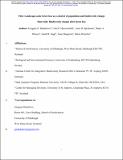Files in this item
Landscape-scale forest loss as a catalyst of population and biodiversity change
Item metadata
| dc.contributor.author | Daskalova, Gergana N. | |
| dc.contributor.author | Myers-Smith, Isla H. | |
| dc.contributor.author | Bjorkman, Anne D. | |
| dc.contributor.author | Blowes, Shane A. | |
| dc.contributor.author | Supp, Sarah R. | |
| dc.contributor.author | Magurran, Anne E. | |
| dc.contributor.author | Dornelas, Maria | |
| dc.date.accessioned | 2021-01-21T11:30:11Z | |
| dc.date.available | 2021-01-21T11:30:11Z | |
| dc.date.issued | 2020-06-19 | |
| dc.identifier | 268667074 | |
| dc.identifier | 36f77454-57fb-4d4b-9010-465a085b0224 | |
| dc.identifier | 32554591 | |
| dc.identifier | 85086692530 | |
| dc.identifier | 000544017600042 | |
| dc.identifier.citation | Daskalova , G N , Myers-Smith , I H , Bjorkman , A D , Blowes , S A , Supp , S R , Magurran , A E & Dornelas , M 2020 , ' Landscape-scale forest loss as a catalyst of population and biodiversity change ' , Science , vol. 368 , no. 6497 , pp. 1341-1347 . https://doi.org/10.1126/science.aba1289 | en |
| dc.identifier.issn | 0036-8075 | |
| dc.identifier.other | RIS: urn:D3E6AFFEC698A125CAD83FC44E6FD0F7 | |
| dc.identifier.other | ORCID: /0000-0002-0036-2795/work/76386811 | |
| dc.identifier.uri | https://hdl.handle.net/10023/21298 | |
| dc.description | The BioTIME database was supported by ERC AdG BioTIME 250189 and ERC PoC BioCHANGE 727440. We thank the ERC projects BioTIME and BioCHANGE for supporting the initial data synthesis work that led to this study, and the Leverhulme Centre for Anthropocene Biodiversity for continued funding of the database. Also supported by a Carnegie-Caledonian PhD Scholarship and NERC doctoral training partnership grant NE/L002558/1 (G.N.D.), a Leverhulme Fellowship and the Leverhulme Centre for Anthropocene Biodiversity (M.D.), Leverhulme Project Grant RPG-2019-402 (A.E.M. and M.D.), and the German Centre of Integrative Biodiversity Research (iDiv) Halle-Jena-Leipzig (funded by the German Research Foundation; FZT 118, S.A.B.). | en |
| dc.description.abstract | Global biodiversity assessments have highlighted land-use change as a key driver of biodiversity change. However, there is little empirical evidence of how habitat transformations such as forest loss and gain are reshaping biodiversity over time. We quantified how change in forest cover has influenced temporal shifts in populations and ecological assemblages from 6090 globally distributed time series across six taxonomic groups. We found that local-scale increases and decreases in abundance, species richness, and temporal species replacement (turnover) were intensified by as much as 48% after forest loss. Temporal lags in population- and assemblage-level shifts after forest loss extended up to 50 years and increased with species’ generation time. Our findings that forest loss catalyzes population and biodiversity change emphasize the complex biotic consequences of land-use change. | |
| dc.format.extent | 8 | |
| dc.format.extent | 3189195 | |
| dc.language.iso | eng | |
| dc.relation.ispartof | Science | en |
| dc.subject | QH301 Biology | en |
| dc.subject | 3rd-DAS | en |
| dc.subject | BDC | en |
| dc.subject | R2C | en |
| dc.subject | SDG 15 - Life on Land | en |
| dc.subject.lcc | QH301 | en |
| dc.title | Landscape-scale forest loss as a catalyst of population and biodiversity change | en |
| dc.type | Journal article | en |
| dc.contributor.sponsor | European Research Council | en |
| dc.contributor.sponsor | European Research Council | en |
| dc.contributor.sponsor | The Leverhulme Trust | en |
| dc.contributor.sponsor | The Leverhulme Trust | en |
| dc.contributor.institution | University of St Andrews. School of Biology | en |
| dc.contributor.institution | University of St Andrews. Centre for Biological Diversity | en |
| dc.contributor.institution | University of St Andrews. Scottish Oceans Institute | en |
| dc.contributor.institution | University of St Andrews. Institute of Behavioural and Neural Sciences | en |
| dc.contributor.institution | University of St Andrews. St Andrews Sustainability Institute | en |
| dc.contributor.institution | University of St Andrews. Centre for Research into Ecological & Environmental Modelling | en |
| dc.contributor.institution | University of St Andrews. Fish Behaviour and Biodiversity Research Group | en |
| dc.contributor.institution | University of St Andrews. Marine Alliance for Science & Technology Scotland | en |
| dc.identifier.doi | 10.1126/science.aba1289 | |
| dc.description.status | Peer reviewed | en |
| dc.identifier.url | https://science.sciencemag.org/content/368/6497/1341/suppl/DC1 | en |
| dc.identifier.url | https://doi.org/10.1101/473645 | en |
| dc.identifier.grantnumber | 250189 | en |
| dc.identifier.grantnumber | 727440 | en |
| dc.identifier.grantnumber | en | |
| dc.identifier.grantnumber | ORPG-8061 | en |
This item appears in the following Collection(s)
Items in the St Andrews Research Repository are protected by copyright, with all rights reserved, unless otherwise indicated.

